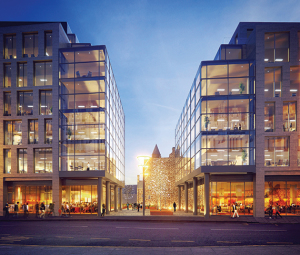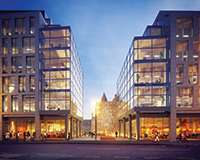 Oil capital Aberdeen has fallen from grace. Until recently, it was often mentioned in the same breath as London when property folk were discussing boom cities. So how have things gone so wrong, so quickly?
Oil capital Aberdeen has fallen from grace. Until recently, it was often mentioned in the same breath as London when property folk were discussing boom cities. So how have things gone so wrong, so quickly?
Until mid-2014, the oil industry and its international reach provided Aberdeen and its shire with a charmed life. While the rest of the world wallowed in post-Lehman blues, the Scottish county was largely unaffected, enjoying high employment levels, huge oil-related salaries and steadily rising house prices.
Aberdeenshire has more multi-millionaires per 100,000 population than even London, according to research firm WealthInsight.
But while the rest of the UK saw a tentative economic recovery, last year the bottom fell out of the oil market and the price of the black stuff began a six-month slide to around $50 per barrel, less than half of its previous price.
Cue massive cost-cutting, staff shedding and ambitious expansion plans shelved. For example, Aberdeen-based Wood Group, which employs about 12,000 people on- and offshore, announced that as from January 2015, it would be paying contract staff (most of the workers on the rigs) 10% less.
This and other related job losses, such as drilling, have hit the local property market hard.
“At the moment, the Aberdeen office market is completely flat,” says Mark Glatman, chief executive of Abstract Securities, developer of a potential 1m sq ft at Aberdeen International Business Park, near the airport. “Our research suggests a large overhang of space – we reckon about 1.7m sq ft.”
Some estimates are even higher. Graeme Duncan, head of commercial for Bidwells in Scotland, says the overhang is 2m sq ft, far in excess of normal annual take-up levels of 800,000 sq ft, although he estimates this year’s letting total will be nearer half, at 400,000 sq ft.
Meanwhile, the speculative development machine is still running and supply is growing.
Major city-centre schemes due to complete in the first half of next year include Knight Property Group’s and M&G Real Estate’s 72,600 sq ft The Capitol, on Union Street. Next door to this is Titan Investors’ 131,611 sq ft Silver Fin Building, due to complete in 2017.
Also due to emerge in 2017 is Muse Developments’ and Aviva’s £107m Marischal Square mixed-use scheme (pictured), which will provide 173,500 sq ft of office space, a four-star hotel, cafés and restaurants. The letting campaign, via Ryden and CBRE, will start in earnest in September 2016 and will target the energy sector and related firms.
Stephen Turner, regional director at Muse, was upbeat about letting prospects when he spoke to Estates Gazette at the scheme’s launch in September. He said: “We believe that, in a year’s time, it’s going to be a better market. So we genuinely think that by the time we complete this building, we’ll have some good occupiers to talk to.”
So why does Aberdeen have this new space hitting the market when the city is in the depths of recession?
Market observers say that, in part, it was because 2014 was “the best year ever” with more than 1m sq ft of take-up. Much of this was attributable to Wood Group leasing 215,000 sq ft in the city’s industrial district, Altens, and Aker Solutions signing for 334,795 sq ft at Aberdeen International Business Park.
This success “put significant strain on the office market”, says Derren McRae, managing director of CBRE’s Aberdeen office. He says that although by the end of 2014 Aberdeen had about 540,000 sq ft of space available, only 27,000 sq ft (5% of available stock) was new, grade-A space.
Between 2009 and 2014, capital values of Aberdeen offices rose by 6.1% pa while Edinburgh office values were virtually static.
McRae and other agents are pragmatic about the pipeline of new product. “From its high point two years ago, we have gone from an extremely hot market in which large deals were happening off market, to a more normal situation in which you actually have to prepare details and put up boards,” he says.
Outside Aberdeen, commentators are less diplomatic. “Before, you couldn’t get offices there – now you can’t give them away,” says the property head of a Glasgow-based legal firm.
Angus MacCuish, head of FG Burnett’s office department, says: “People are pressing the panic button. There seems to be a fear of grade-A space, but it is unhealthy not to have space coming through the development pipeline. We need to be able to accommodate companies that want to trade up.”
Meanwhile, better news appears to be on the horizon as new overseas-based oil businesses still want to set up in Aberdeen and acquire North Sea oil assets.
“The danger is that if we don’t have the space available, investment could be lost to the local economy,” says MacCuish. “The international nature of the oil sector means that new occupiers could go elsewhere in the world and then they will never come back.”
Uncertainty about the duration and effects of the oil price slump, in particular how much prelet space will come back to the market, make specific predictions about 2016 hard to come by in Aberdeen.
Glatman is ready to play the waiting game. “The pause lets infrastructure catch up,” he says, referring to the Aberdeen Western Peripheral Route, which is under construction.
But he adds: “In the short term, very little will happen in Aberdeen.”
2015 office deals
Among this year’s larger city-centre deals was KCA Deutag’s leasing of 70,000 sq ft at City South and 43,000 sq ft taken by Amec at the 121,600 sq ft Annan House, which completed mid-year. Out of town, prelets were signed at Prime Four Business Park to LR Senergy for 100,000 sq ft and to Anderson Brown, which is taking 45,000 sq ft.











